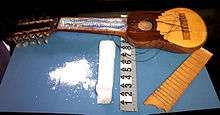Iron law of prohibition
.jpg)
The iron law of prohibition is a term coined by Richard Cowan in 1986 which posits that as law enforcement becomes more intense, the potency of prohibited substances increases.[1] Cowan put it this way: "the harder the enforcement, the harder the drugs."[2]
This law is an application of the Alchian–Allen effect; Libertarian judge James P. Gray calls the law the "cardinal rule of prohibition", and notes that is a powerful tool for the legalization of drugs.[1][3] It is based on the premise that when drugs or alcohol are prohibited, they will be produced in black markets in more concentrated and powerful forms, because these more potent forms offer better efficiency in the business model—they take up less space in storage, less weight in transportation, and they sell for more money. Economist Mark Thornton writes that the iron law of prohibition undermines the argument in favor of prohibition, because the higher potency forms are less safe for the consumer.[4]
Findings

Thornton published research showing that the potency of marijuana increased in response to higher enforcement budgets. He later expanded this research in his dissertation to include other illegal drugs and alcohol during Prohibition in the United States (1920–1933). The basic approach is based on the Alchian and Allen Theorem. This argument says that a fixed cost (e.g. transportation fee) added to the price of two varieties of the same product (e.g. high quality red apple and a low quality red apple) results in greater sales of the more expensive variety. When applied to rum-running, drug smuggling, and blockade running the more potent products become the sole focus of the suppliers. Thornton notes that the greatest added cost in illegal sales is the avoidance of detection.[4] Thornton says that if drugs are legalized, then consumers will begin to wean themselves of the higher potency forms, for instance with cocaine users buying coca leaves, and heroin users switching to opium.[5]
The popular shift from beer to wine to hard liquor during the US Prohibition era[6] has a parallel in the narcotics trade in the late 20th century. Bulky opium was illegal, so refined heroin became more prevalent, albeit with significant risk from blood-borne disease because of injection by needle, and far greater risk of death from overdose. Marijuana was also found too bulky and troublesome to smuggle across borders, so smugglers turned to refined cocaine with its much higher potency and profit per pound.[7] Cowan wrote in 1986 that crack cocaine was entirely a product of the prohibition of drugs.[2] Clinical psychiatrist Michael J. Reznicek adds crystal meth to this list.[8]
With underage drinking by teens in the U.S., one of the impacts of laws against possession of alcohol by minors is that teens tend to prefer distilled spirits, because they are easier to conceal than beer.
References
- 1 2 Mosher, Clayton J.; Akins, Scott (2007). Drugs and Drug Policy: The Control of Consciousness Alteration. SAGE. pp. 308–09. ISBN 0761930078.
- 1 2 Cowan, Richard (December 5, 1986). "How the Narcs Created Crack: A War Against Ourselves". National Review. 38 (23): 26–34.
- ↑ Gray, James P. (2001). Why Our Drug Laws Have Failed: A Judicial Indictment Of War On Drugs. Temple University Press. ISBN 978-1-56639-860-2.
- 1 2 Thornton, Mark (July 17, 1991). "Alcohol Prohibition Was A Failure". Policy Analysis. Cato. Retrieved December 20, 2013.
- ↑ Levinson, David (2002). Encyclopedia of Crime and Punishment. SAGE. p. 561. ISBN 076192258X.
- ↑ Mendelson, Richard (2009). From Demon to Darling: A Legal History of Wine in America. University of California Press. pp. 50–51. ISBN 0520259432.
- ↑ Healy, Gene (2008). "Drug Prohibition". In Hamowy, Ronald. The Encyclopedia of Libertarianism. Thousand Oaks, CA: SAGE; Cato Institute. pp. 128–29. ISBN 978-1-4129-6580-4. LCCN 2008009151. OCLC 750831024.
- ↑ Reznicek, Michael J. (2012). Blowing Smoke: Rethinking the War on Drugs Without Prohibition and Rehab. Rowman & Littlefield. p. 154. ISBN 1442215143.
- Thornton, Mark (1991). The Economics of Prohibition (PDF). Salt Lake City: University of Utah Press.
- Lavine, Harry; Reinarman, Craig (1991). "From Prohibition to Regulation". Milbank Quarterly. 69 (2).
- Ekelund, Robert B.; Thornton, Mark (1992). "The Union Blockade and Demoralization of the South: Relative Prices in the Confederacy". Social Science Quarterly. 73 (4): 890–902.
- Thornton, Mark (1998). "The Potency of Illegal Drugs". Journal of Drug Issues. 28 (3): 725–40.
- Thornton, Mark (January 20, 2011). "What Explains Crystal Meth?". Mises Daily.